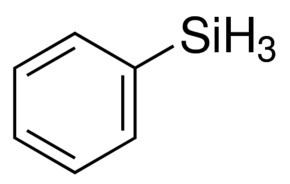Formula C6H8Si Molar mass 108.22 g/mol | Density 878 kg/m³ Appearance Colorless liquid | |
 | ||
Phenylsilane, also known as silylbenzene, a colorless liquid, is one of the simplest organosilanes with the formula C6H5SiH3. It is structurally related to toluene, with a silyl group replacing the methyl group. Both of these compounds have similar densities and boiling points due to these similarities. Phenylsilane is soluble in organic solvents.
Contents
Synthesis and reactions
Phenylsilane is produced in two steps from Si(OEt)4. In the first step, phenylmagnesium bromide is added to form Ph-Si(OEt)3 via a Grignard reaction. Reduction of the resulting Ph-Si(OEt)3 product with LiAlH4 affords phenylsilane.
Ph-MgBr + Si(OEt)4 → Ph-Si(OEt)3 + MgBr(OEt)4 Ph-Si(OEt)3 + 3 LiAlH4 → 4 Ph-SiH3 + 3 LiAl(OEt)4Uses
Phenylsilane can be used to reduce tertiary phosphine oxides to the corresponding tertiary phosphine.
P(CH3)3O + PhSiH3 --> P(CH3)3 + PhSiH2OHThe use of phenylsilane proceeds with retention of configuration at the phosphine. For example, cyclic chiral tertiary phosphine oxides can be reduced to cyclic tertiary phosphines.
Phenylsilane can also be combined with cesium fluoride. In aprotic solvents, it becomes a nonnucleophilic hydride donor. Specifically, phenylsilane-caesium fluoride has been shown to reduce 4-oxazolium salts to 4-oxazolines. This reduction gives yields of 95%.
